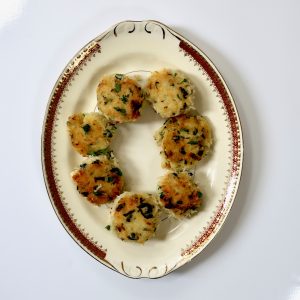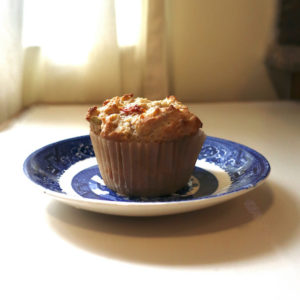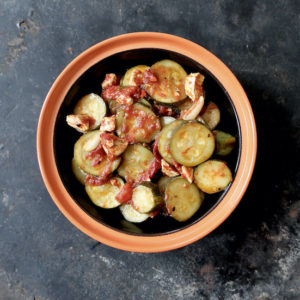Cheese Straws
Some readers may feel cheese straws are right up there with gelatin molds involving mayonnaise. Stay with me, for the cheese straw has possibilities beyond the dinner-party-appetizer-with-drinks. I mean, seriously, do you ever hear me discussing my dinner party plans? Right. So hang in there.

Cheese straws do necessitate turning on the oven, but not for long. Beyond that, they’re cheap, made of ingredients you likely have lying around, and require no manual dexterity whatsoever–I made them, what else do you need to know?–and even more amazingly, they keep well. So long as you have an airtight tin, you’re in business.

Early attempt at cheese straws, in airtight tin.
The further good news on the cheese straw front–I’m sorry to say, good news is scant pretty much everywhere else–is these babies invite improvisation. Add some cayenne? Why not? Seedy mustard? Why ever not? Salt? What kind were you thinking? Garlic? Minced scallion? Bring it on!

Were all this not enough, I am pleased to report cheese straws have applications beyond the dinner party aperitif. They are delicious alongside soup, crumbled into salads, or eaten any time you might otherwise crave a potato chip.

Finally, this dough also works beautifully as a cracker. Instead of slicing it lengthwise, use a biscuit cutter to stamp out shapes, or slice it into squares.

The other thing I should tell you, and I’ve gotten very far into this post before saying so, is the original recipe for cheese straws comes from Tamasin Day-Lewis, and may be found in her indispensible Kitchen Bible, a book that truly lives up to its name.
I’ve made some adjustments to the original recipe, which represent an American cook working in an American kitchen, using a gas oven rather than a solid fuel Aga.

—
A few notes:
Depending on your kitchen, your flour, and your chosen flavor variations, you may need to add water to the dough. Or you may not.

There is no water in that cup.
A scale is helpful but not crucial. If you have a scale that toggles between metric and imperial, use metric.

Not a scale, but we really needed a picture here.
Day-Lewis called for an oven temperature of 180C/350F in her recipe. My cheese straws did better at 190C/375F.
This recipe leaves you with leftover egg white. You can freeze the white in a ziploc bag, or refrigerate it in a covered container for a few days. I use up the extra white by pouring it over hot cooked rice.

Just because the cheese straw is open to tinkering doesn’t mean it’s a culinary mudpie. This is a delicate dough: if you try adding too many flavorings, it will repay you by falling apart. The magic number seems to be two.

This same fragility means the dough is prone to breaking during the cutting process. It may also try falling apart while being moved to the baking tray. It helps to slip the cheese straw over to the flat edge of the knife, then use the knife to convey the straw to the baking tray (see below). But cheese straws are meant to look a bit rustic, so I wouldn’t fret about this too much.

Finally, my husband wants you to know he calls cheese straws “dough french fries.”

Cheese Straws
Adapted from Tamasin Day-Lewis’s Kitchen Bible
Prep time: about 15 minutes
Baking time: about 20 minutes
Yield: 30-40 cheese straws, depending on slicing technique
Please read the notes, below, for a discussion of the many possible recipe variations.
45 grams/1.5 ounces sharp Cheddar cheese, grated
1 egg yolk
170 grams/6 ounces/3/4 cup AP Flour
1 teaspoon fine sea salt
1 teaspoon pepper
100 grams/4 ounces unsalted butter, cold
enough water to bind, if needed
Additions: Add no more than two, or your dough may fall apart:
1-2 teaspoons horseradish
1-2 teaspoons Worcestshire sauce
1-2 teaspoons seedy mustard
1-2 teaspoons English mustard (i.e. powdered)
1-2 teaspoons cayenne pepper
1/4 teaspoon-1 teaspoon hot red pepper flakes (consider your eaters here)
1-2 teaspoons sumac
1-2 teaspoons ground pomegranate seed
1-2 teaspoons chaat masala
1 small garlic clove, crushed to remove the peel, then very finely minced
the green portion of 1 scallion, very finely minced
Preheat the oven to 375F/190C
Line a large baking sheet with parchment paper or a silicon baking liner.
Either grate the cheese into a medium bowl or pare it finely with a vegetable parer. If you’re confident about your egg-separating abilities, you can separate the egg into the cheese, but I’m not deft enough and prefer doing this in separate bowls.
Measure the flour into a large bowl. Add the salt and pepper.
Cut the butter into small pieces and add these to the flour. Using a pastry cutter, two forks, or your clean fingertips, blend the butter and flour until the dough begins to cohere.
Add the egg, cheese, and your chosen variations to the flour/butter mixture. Mix until you have a dough. You may need to add some water; this depends on weather, your kitchen, and the ingredients.
Once the dough begins coming together, lightly flour a clean work surface and dump the dough out. It can still be pretty rough. Knead into a ball, and allow it to rest a few minutes–while the dough rests, you can do the washing up.
After five to ten minutes, flour a rolling pin lightly. Flour the dough ball very lightly, and gently roll/pat it into a rough square:

I know pictures in recipes are a hassle, but in this instance I hopes it helps.
With a sharp knife, slice the dough thinly-or thickly–into straws. As noted in the post, the dough breaks easily. It helps to slip the straw on to the flat edge of the knife, and move it over to the baking tray that way. But don’t fret too much over this.
Line up the straws as best you can on the baking tray; the process can get messy, in my experience.
Once all the dough is sliced, bake for about 20 minutes. You want the straws golden but not browned.
Allow to cheese straws to cool on a rack before storing in an airtight tin. Cheese straws will keep 8-10 days.
To freeze cheese straws, open freeze slice, unbaked straws on lined baking sheet. Once they’re frozen, store them in a freezer bag and bake from frozen, allowing a bit more baking time.
Notes:
Other sharp or strongly flavored cheeses may be used here, like Parmesan, Manchego, or Gouda.
If you want to make crackers, a less intense dough is recommended–hold back on spices on like cayenne or hot pepper flakes. Remember crackers are a base, not the reason to eat.
In Oakland. 




